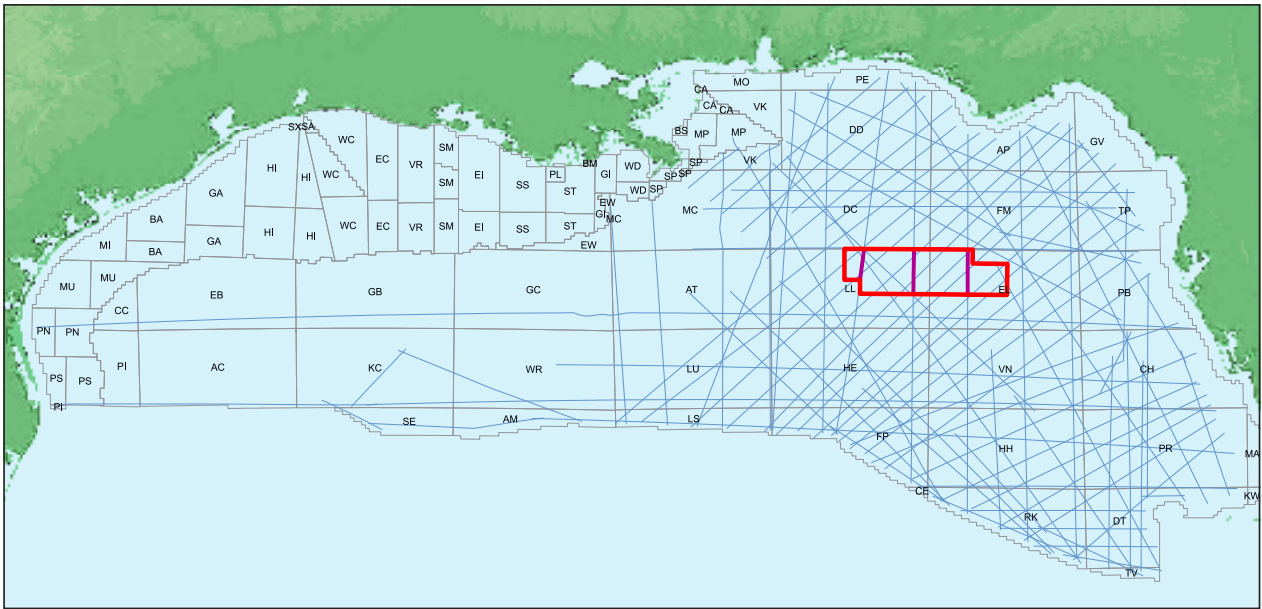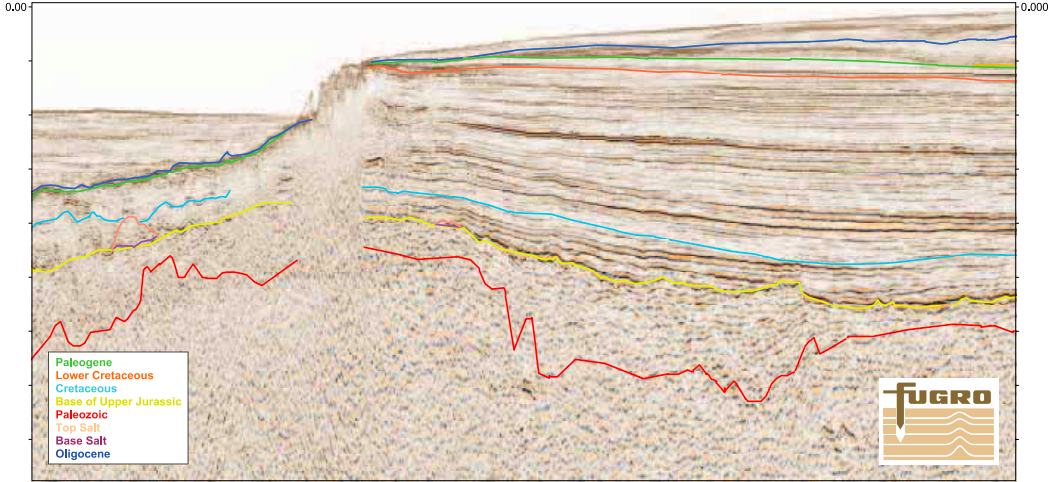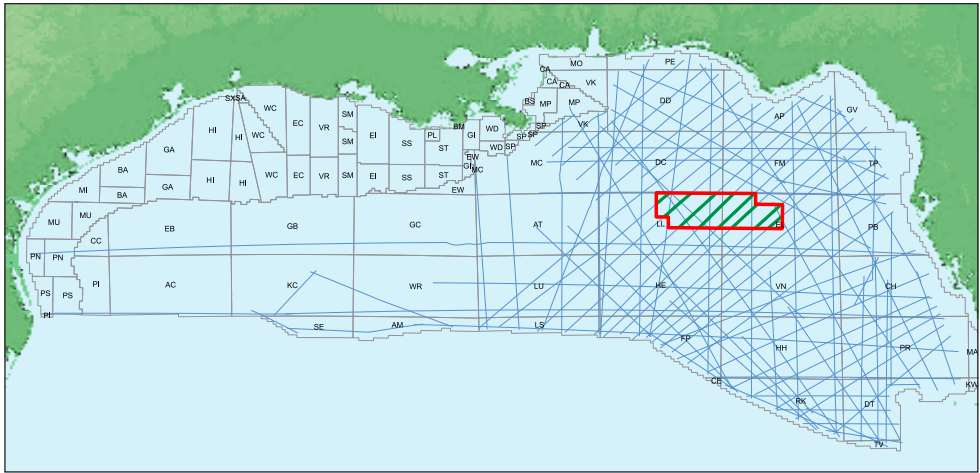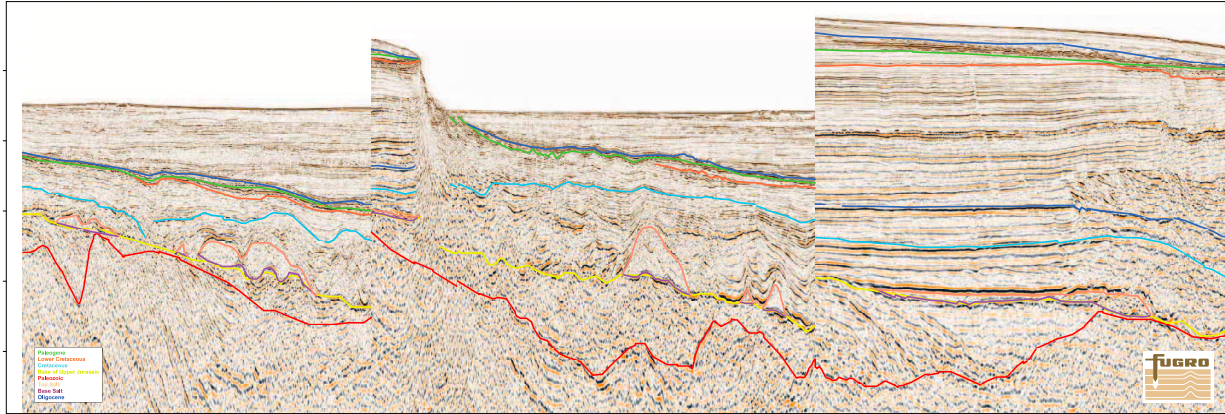
Offshore Florida
A west-east seismic line on the north side of the 3D survey shows the thinning of the Mesozoic (green to yellow) strata across the shelf and slope. A series of pre-Louann salt basins below the yellow horizon have been interpreted on the line. Source: FugroOffshore Florida has a long, interrupted history of exploration – and plenty of potential.
Many writers call Florida a ‘frontier’, but the region has a long, interrupted and challenging history of oil and gas exploration. These are a few of the major events:
- Sunniland Field (discovered in 1943) and a few other oil fields in the Sunniland trend that have been producing since the 1940s.
- The first Federal Lease Sale was held in 1959. From this sale, 23 blocks were leased and three wells were drilled offshore Florida. Gulf Oil Corp drilled oil off the Marquesas Key in 1959.
- Drilling in the offshore regions of the Eastern Gulf started in the mid 1970s with the drilling of Destin Dome Block 162. During this time, two years of drilling resulted in 15 dry holes and the discovery of gas around Destin Dome, but no significant discoveries in other regions of the offshore Eastern Gulf.
- Three Eastern Gulf lease sales in the 1980s were a result of higher oil prices and Area Wide Lease Sales, which created new interest in this region. During development of the 1987 to 1992 Oil and Gas Leasing Program, the Eastern Gulf was proposed to extend into Florida Bay and to the Florida Keys.
- Exploration evolved into a campaign issue with Florida and a call for the 100-mile (160 km) coastline buffer. Congress has included yearly moratoria language prohibiting new leasing offshore Florida and the Eastern Planing Area since 1989. The last moratorium was allowed to expire on September 30, 2008.
- Between 1997 and 2002 there was one Lease Sale covering a small part of the Eastern Gulf. This Lease Sale 181 area was modified to maintain the 100-mile (160 km) buffer offshore Alabama and Florida. The area was further modified from 5.9 million acres (24,000 km2) to 1.47 million acres (6,000 km2) by the state of Florida to include just a small portion of the area offshore Alabama that was located 100 miles (160 km) off the coast of Florida. Further sales within this area were held subsequently.
- In 1998 President Clinton withdrew the majority of the Eastern Gulf from new leasing through June 30, 2012.
- On July 14, 2008, President Bush suspended the withdrawal.
- First production in the Eastern Gulf was in February 1999 on Pensacola Block 881 by Unocal (Spirit Energy). Many of the other leaseholders became embroiled in a dispute with the government that was eventually settled by most operators in 2002.
- In 2006 the Gulf of Mexico Energy Security Act (GOMESA) was implemented. This included areas 125 miles (200 km) offshore Florida and 100 miles (160 km) offshore Florida and 100 miles (160 km) from the Florida coast offshore adjacent states.
- In 2009 legislation to open state waters offshore Florida was introduced and positive discussion with regards to the Federal OCS was circulating through the industry.
- In early 2010 the Obama administration moved to open up large portions of the East Coast and Eastern Gulf of Mexico to exploration and drilling.
- On April 20, 2010, the Macondo disaster resulted in a seven-year ban placed on exploration in the Eastern Gulf of Mexico by the Federal Government.

Plenty of potential
The information from the wells drilled offshore Florida provides geoscientists with good basic geological knowledge that can be used to develop new ideas and concepts for future exploration. New trends in the Deep Water regions such as discovered through the Shiloh and Appomattox wells and others have encouraged companies to look at the potential of the Eastern planning area for extending these trends. Explorationists are always using both old and new ideas and technologies to find hydrocarbons. Fugro is supporting theses efforts with new regional 2D data as well as with a new long offset 3D survey covering 500 blocks.
There are many good reasons to explore this region. With oil prices high, there will be a time when America will need to search for additional natural resources. Offshore Florida is probably the easiest and fastest to market, both from a geological and engineering standpoint. Geologically it is similar to the areas explored onshore Alabama and parts of the Central planning area.
From an engineering standpoint, companies have been operating in the Gulf and they understand the climate and environment with respect to drilling and development. Coupled with this, the existing support and infrastructure is not far away, making Florida one of the easier future exploration areas. Concerns regarding the environment and beaches are reduced because of new mitigation methods and new government regulations. Better knowledge of the OCS through detailed information should result in better decisions across the board. Oil is over $100 per barrel and the industry will need to find new resources in our own territorial waters. For once, a 3D survey will be ready before the Lease Sale and should provide clients with plenty of time to evaluate the data as well as giving the BOEM a base from which to evaluate future bids.





